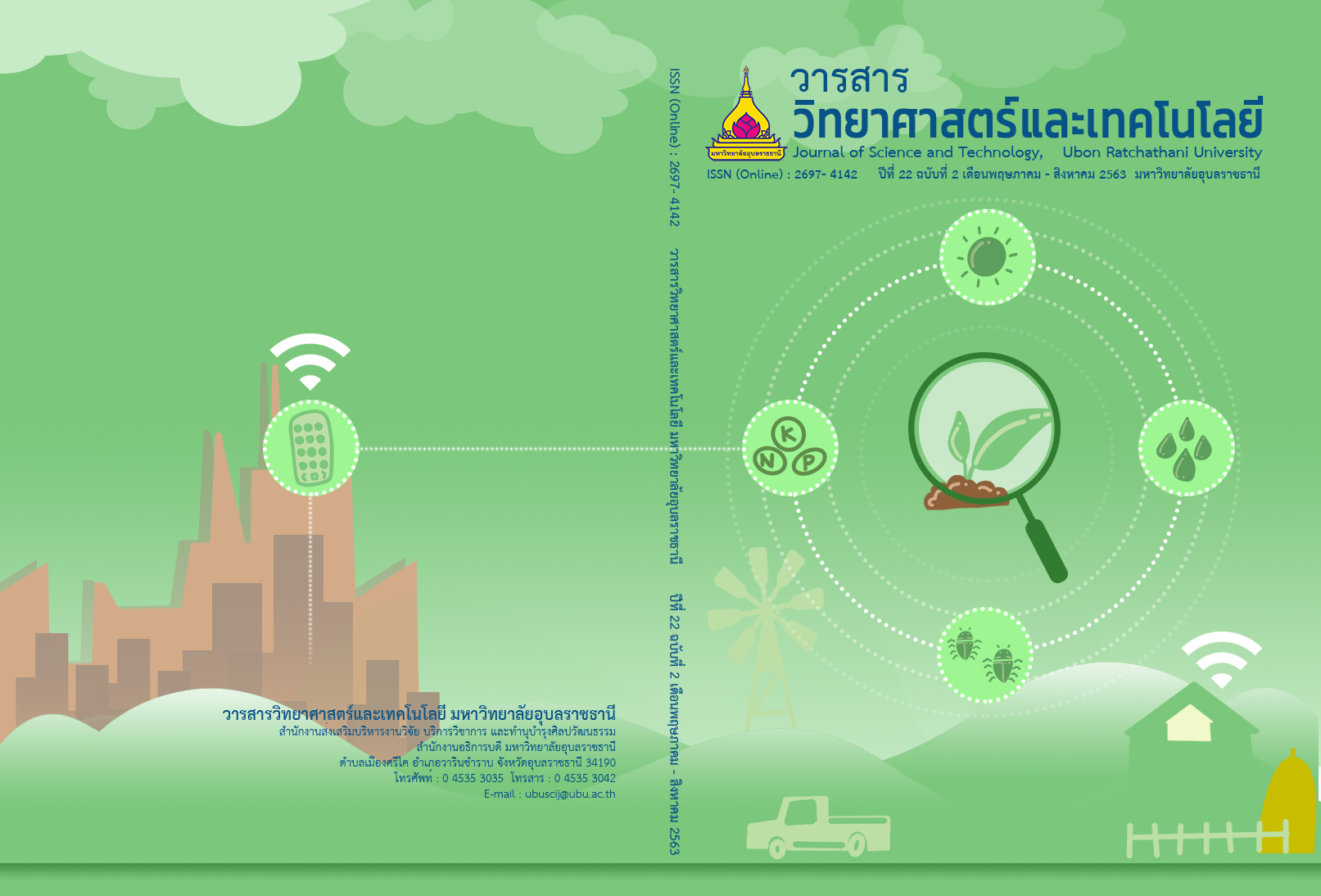การคัดแยกและศึกษาคุณสมบัติการเป็นโพรไบโอติกของแบคทีเรียกรดแลคติก ที่คัดแยกจากกล้วยน้ำว้าดิบในเขตจังหวัดพิษณุโลก
Main Article Content
บทคัดย่อ
วัตถุประสงค์ของการศึกษาครั้งนี้เพื่อคัดแยกแบคทีเรียกรดแลคติก (Lactic acid bacteria; LAB) จากกล้วยน้ำว้าดิบระยะที่ 1 ในจังหวัดพิษณุโลก และศึกษาคุณสมบัติการเป็นโพรไบโอติกเบื้องต้นของ LAB ที่คัดแยกได้ รวมถึงระบุสายพันธุ์จุลินทรีย์ด้วยเทคนิคทางอณูชีววิทยา โดยศึกษาลักษณะทางสัณฐานวิทยาเบื้องต้น ทดสอบการย่อยสลายเม็ดเลือดแดง ความสามารถในการทนเกลือน้ำดี 0.5% ความสามารถในการทนกรด-ด่างที่ 2-9 ความสามารถในการยับยั้งจุลินทรีย์ก่อโรคทางเดินอาหาร และความไวต่อยาปฏิชีวนะ จากการศึกษาพบว่า สามารถคัดแยก LAB จากกล้วยน้ำว้าดิบระยะที่ 1 ได้ทั้งหมด 35 ไอโซเลต (แกรมบวก รูปร่างกลม ไม่สร้างเอนไซม์คะตะเลส (catalase) แต่มีเพียง 7 ไอโซเลต ที่ไม่ย่อยเม็ดเลือดแดง คือ NR19, NR22, NR23, NR24, NR27, NR28 และ NR38 ซึ่งทั้ง 7 ไอโซเลต สามารถทนเกลือน้ำดี 0.5% ได้โดยมีอัตราการรอดชีวิตมากกว่า 90% และทนต่อสภาวะความเป็นกรด-ด่างที่ 2-9 ได้ ซึ่งมีอัตราการรอดชีวิต ≥ 40% และมีเพียง 4 ไอโซเลต NR19, NR23, NR24 และ NR27 ที่สามารถยับยั้งจุลินทรีย์ก่อโรคสายพันธุ์ Escherichia coli, Bacillus cereus, Staphylococcus aureus และ Salmonella Typhimurium ได้ทั้งหมด นอกจากนี้ LAB ทั้ง 7 ไอโซเลต มีความไวต่อยาปฏิชีวนะ Tetracyclines Chloramphenicol และ Ampicillin และหลังจากระบุสายพันธุ์จุลินทรีย์ด้วยการวิเคราะห์ลำดับนิวคลีโอไทด์ของ 16S rDNA พบว่ามีความคล้ายคลึงกับ Enterococcus gallinarum (NR19) Lactococcus lactis ssp. (NR22, NR23, NR24 และ NR38) และ Weisssella paramesenteroides (NR27 และ NR28) ผลการวิจัยแสดงให้เห็นว่า LAB ทั้ง 7 ไอโซเลต มีแนวโน้มที่จะเป็นโพรไบโอติก และคาดว่าจะสามารถนำไปพัฒนาเป็นผลิตภัณฑ์อาหารเสริมสุขภาพต่อไปได้
Article Details
บทความที่ได้รับการตีพิมพ์เป็นลิขสิทธิ์ของ วารสารวิทยาศาสตร์และเทคโนโลยี มหาวิทยาลัยอุบลราชธานี
ข้อความที่ปรากฏในบทความแต่ละเรื่องในวารสารวิชาการเล่มนี้เป็นความคิดเห็นส่วนตัวของผู้เขียนแต่ละท่านไม่เกี่ยวข้องกับมหาวิทยาลัยอุบลราชธานี และคณาจารย์ท่านอื่นๆในมหาวิทยาลัยฯ แต่อย่างใด ความรับผิดชอบองค์ประกอบทั้งหมดของบทความแต่ละเรื่องเป็นของผู้เขียนแต่ละท่าน หากมีความผิดพลาดใดๆ ผู้เขียนแต่ละท่านจะรับผิดชอบบทความของตนเองแต่ผู้เดียว
เอกสารอ้างอิง
[2] Prakarn Rudeekulthamrong and Jarunee Kaulpiboon. 2012. “Prebiotics: Health-Promoting Food”. Thammasat Medical Journal. 12(2): 362-369. (in Thai)
[3] Evange´ lica Fuentes-Zaragoza and et al. 2011. “Resistant starch as prebiotic: A review”. starch journal. 63: 406-415.
[3] Topping, D. L., Fukushima, M. and Bird, A. R. 2003. Resistant starch as a prebiotic and symbiotic. Proceedings of the 7th Nutrition Society, 27-30 may 2002. 62: 171-176.
[4] Argyri, A.A. and et al. 2013. “Selection of potential probiotic lactic acid bacteria from fermented olives by in vitro tests”. Food Microbiol. 33(2): 282-291.
[5] Brink, M. and et al. 2006. “The effect of prebiotics on production of antimicrobial compounds, resistance to growth at low pH and in the presence of bile, and adhesion of probiotic cells to intestinal mucus”. Journal of Applied Microbiology, 100(4): 813-820.
[6] Begley, M., Hill, C. and Gahan, C.G. 2006. “Bile salt hydrolase activity in probiotics”. applied environmental microbiology. 72(3): 1729-1738.
[7] Lan Q, and et al. 2009. Large-scale evaluation of candidate genes identifies associations between DNA repair and genomic maintenance and development of benzene hematotoxicity. Carcinogenesis. 30(1): 50-80.
[8] CLSI. 2016. CLSI Supplement M100S. Performance Standards for Antimicrobial Susceptibility Testing, 26th Edn. Wayne, PA: Clinical and Laboratory Standards Institute.
[9] Nopchinda s. 2015. “Probiotics for Health Promotion”. Journal of The Royal Thai Army Nurses. 15(3): 430-435. (in Thai)
[10] Englyst, H.N. and Hudson, G.J. 1992. The classification and measurement of dietary carbohydrates. Food Chemistry. 57: 15-21.
[11] Asp, N. G., and Bjorck, I. 1992. “Resistant starch”. Trends in Food Science & Technology 3 (5): 111–114.
[12] Ratithammatorn T. 2017. “Resistant Starch”. Burapha Science Journal. 22(1): 166-176. (in Thai)
[13] Cotter, P.D. and Hill, C. 2003. “Surviving the acid test: responses of gram-positive bacteria to low pH”. Microbiology and Molecular Biology Reviews. 67(3): 429-453.
[14] Kivanç, M., and Yilmaz, M. 2011. “Isolation and identification of lactic acid bacteria from boza and their microbial activity against several reporter strains”. Turkish Journal of Biology. 35: 313–324.
[15] Sanders, M. E. and et al. 2010. “Safety assessment of probiotic”. Gut Microbes. 1(3): 164–185.
[16] Mahantesh M Patil and et al. 2010. “Isolation and characterization of lactic acid bacteria from curd and cucumber”. Indian Journal of Biotechnology 9(2): 166-172.
[17] Ndagano D. and et al. 2011. “Antifungal Activity of 2 Lactic Acid Bacteria of the Weissella Genus Isolated from Food”. International Journal of Food Science. 76(6): 305-311.


